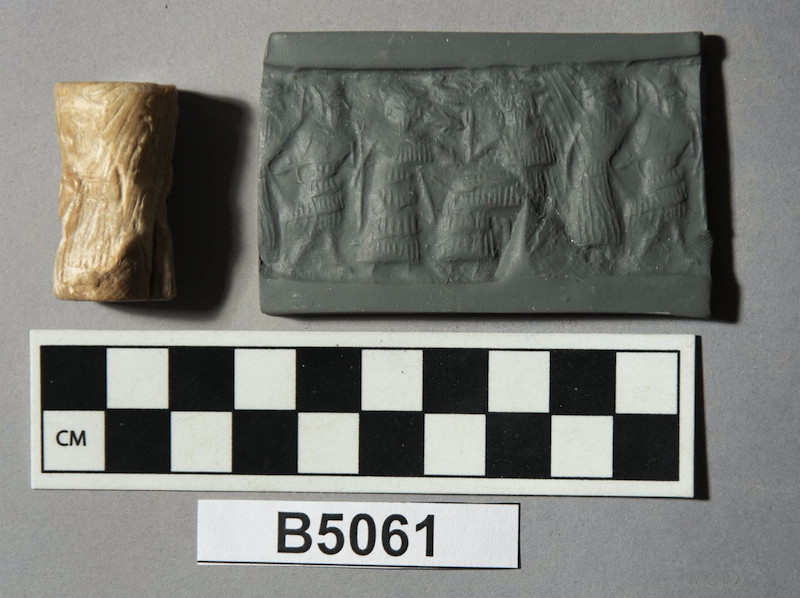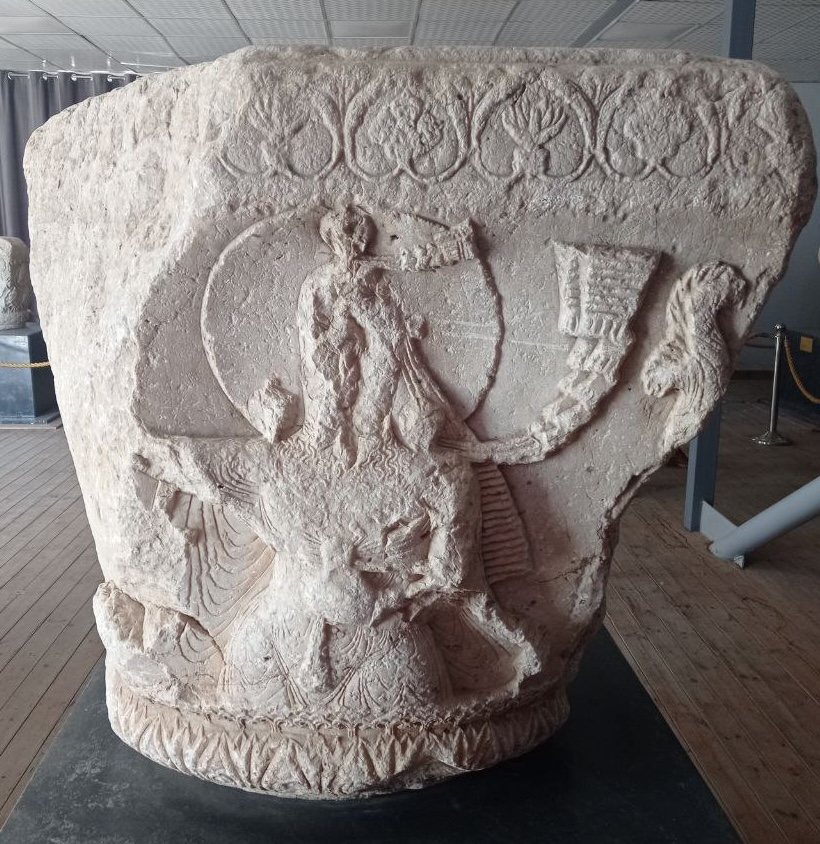Thread: This is a very interesting seal from the Babylonian period (I presume first half of the 2nd millennium BC), currently in the Penn museum. penn.museum/collections/ob… 

It is one of several seals kept in this museum which show "the judgment of the birdman"...
penn.museum/collections/ob…
penn.museum/collections/ob…

The birdman, who has head, arms, chest of a man and the body, legs, feet, wings and tail of a bird, is led by a divine officer, with clasped hands, wearing a long skirt. From behind, he is pushed by the second divine officer, who carries a club, and short skirt... 

At the end of the procession, a human worshiper, with bare head, short hair, long beard and plaited skirt brings a kid (baby goat) as an offering...
He is probably a king. I explained why here:
He is probably a king. I explained why here:
https://twitter.com/serbiaireland/status/1397280984224129034
The birdman is brought before the seated Enki/Ea, who is surrounded by streams, with fish swiming along the stream towards him...He is holding a round vase in his left hand....Above him is a crescent moon pointing upward and stars... 

Very cool...What does this mean? To figure this out, we need to look at another, much older and much cooler seal. This one, apparently from Nipur, and dated to before 3000BC depicts "the judgment of the bird, not the birdman"... penn.museum/sites/journal/… 

The eagle is captured by two divine attendants and probably brought in judgment before Enki/Ea. The bird – this time not a birdman – is fighting with claws and wings to free himself...
One attendant has caught him by the leg and kneels down as if to avoid his wings and beak. The other stands up and grasps one flapping wing while striking him with a short club...
A third officer leads in front with a club on his shoulder. All have the horned mitre, the symbol of divine officers, their hair tied in a loop behind, and flounced skirt leaving bare the upper body...
Soooo??? Remember my article about ferns, feathers, lightning, feather/fern like lightning scars and thunder gods? oldeuropeanculture.blogspot.com/2019/09/pero.h… 







In it, I talked about Ninurta/Ningirsu, Sumerian thunder god, who was in the earliest times imagined as a huge black bird, with outstretched wings...An eagle (vulture)...The Thunderbird....
"...and when Gudea sees the god Ninurta/Ningirsu in a dream the god still has the wings of his old form, the Thunderbird..."
And I then talked about the evolution of the eagle (thunderbird), into the eagle man (birdman), and then further into a thunder god (who can transform into an eagle, can ride on an eagle or has eagle as his sacred animal, avatar)...
Could the birdman on the Babylonian seals be Ninurta/Ningirsu in his old birdman form? And could this bird on the Nipur seal be also Ninurta/Ningirsu in his oldest, thunderbird form?
But why would Ninurta/Ningirsu be arrested and brought before Enki/Ea to be judged? Well, remember my article about Ninurta and the turtle? oldeuropeanculture.blogspot.com/2021/05/ninurt… 

There is a "weird" Sumerian text called "Ninurta and the turtle". In it, the Rain god Ninurta contemplates to overthrow the Flood god Enki. Enki gets the wind of it, and then unleashes a deadly turtle, which digs a huge hole and drags Ninurta into it...
This apparently nonsensical story makes a lot of sense, when you look at Ninurta, Enki and the turtle as calendar markers.
The climatic year in Mesopotamia is divided into two halves: summer, hot and dry half (Apr/May-Oct/Nov) and winter, cool and wet half (Oct/Nov-Apr/May)...
The climatic year in Mesopotamia is divided into two halves: summer, hot and dry half (Apr/May-Oct/Nov) and winter, cool and wet half (Oct/Nov-Apr/May)...

The winter starts in Oct/Nov, with the rain, brought by the rain god Ninurta...And right at that time vultures start their mating season...Huge eagles with outstretched wings gliding below the gathering clouds performing their mating ritual flights... 



And it ends in Apr/May...With the flood, brought by the flood god Enki...And right at the end of the rains season, at the peak of the flood, the Mesopotamian softshell turtles start digging huge holes in river and canal banks to lay their eggs... 

The rain season starts with the beginning of the vulture mating season and ends with the beginning of the flood and the turtle mating season...Turtle drags eagle into the hole in the ground...Rain season ends. Flood starts...Enki overpowers Ninurta... 

This is what "Ninurta and the turtle" story symbolically depicts. So "imprisoning" of the the bird and the birdman, and bringing them to be judged by Enki/Ea, is another symbolic depiction of Enki/Ea overpowering Ninurta/Ningirsu...
The moon pointing up is another sign that we are talking about winter, the rain season...I talked more about this here. oldeuropeanculture.blogspot.com/2020/06/7-star… I think, that moon points up between Ninurta (beginning of rain season) and Enki (end of the rain season). Hence moon being so important 

So my hunch, that the names of all these "Per" thunder gods: Slavic Perun, Baltic Perkūnas/Pērkons, Finnish Perkele, Albanian Perëndi, Indian Parjanya, Thracian Περκων/Περκος, are derived from PIE "*perH-" meaning feather, wing, to fly, just got more support...Amazing really...
• • •
Missing some Tweet in this thread? You can try to
force a refresh























